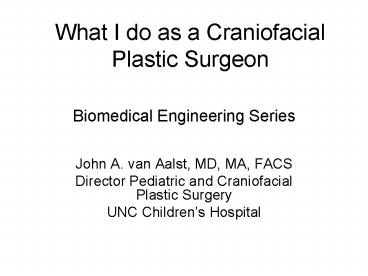Biomedical Engineering Series PowerPoint PPT Presentation
1 / 49
Title: Biomedical Engineering Series
1
Biomedical Engineering Series
What I do as a Craniofacial Plastic Surgeon
- John A. van Aalst, MD, MA, FACS
- Director Pediatric and Craniofacial Plastic
Surgery - UNC Childrens Hospital
2
Overview
- Patient care
- Cleft lip and palate
- Craniosynostosis
- Distraction
- Microtia
- Basic Science
- Nanofibers
- Stem cells
- Overseas work
- West Bank/Gaza
3
Incidence
- Cleft Lip /- Cleft palate (Primary Palate)
- 1/400 500 American Indian, Asian
- 1/700 900 Caucasian
- 1/2000 African American
- Cleft Palate (Secondary Palate)
- 1/2000
- gt 400 Syndromes
- Multifactorial
- Genes
- gt 400 single gene causes of cleft lip/palate
- Environment
4
Embryologic Timeline
22-27 d
27 d
30 d
28 d
42 d
50 d
21 d
Birth
Palate fusion
Lip fusion
Branchial Arch formation
Nasal Placode formation
Neural Crest migration
Neural Tube closure
Gastrulation
5
In-Utero Diagnosis
6
Advancement
Rotation
7
(No Transcript)
8
(No Transcript)
9
(No Transcript)
10
(No Transcript)
11
(No Transcript)
12
(No Transcript)
13
Normal Suture Closure
- Time in years
- Metopic 2
- Sagittal 22
- Coronal 24
- Lambdoid 26
- Palatal 30 35
- Frontonasal 68
- Frontozygomatic 72
14
Growth Perpendicular to Sutures
15
Incidence of Craniosynostosis
- US incidence 0.04 - 0.1 of general population
- 1/1,900 live births
- 2 - 8 have primary craniosynostosis
- Remaining are secondary craniosynostoses
- Accompanied by microcephaly
- Sagittal 50 - 58
- Coronal 20 - 29
- Metopic 4 - 10
- Lambdoid 2 - 4.
16
(No Transcript)
17
(No Transcript)
18
(No Transcript)
19
(No Transcript)
20
(No Transcript)
21
Microtia
- Microtia
- 1/6,000 Westerners
- 1/3,000 Japanese
- 1/1,200 Navajo Indians
- Reconstruction
- Rib cartilage
- 5-7 years of age
- 3 or 4 stages
22
(No Transcript)
23
(No Transcript)
24
(No Transcript)
25
- Birth
- Multi-disciplinary evaluation
- Airway and feeding problems
- 14 days
- Bronchoscopy/laryngoscopy
- Grade IV view of larynx
- 24 days
- Distraction initiated
26
24 days
Left
Right
27
Day 1
28
Day 15
29
(No Transcript)
30
5 months
31
Soft Tissue Evaluation
32
(No Transcript)
33
Evaluation of Movement
34
Distinguishing Between Soft Tissue and Bone
35
Craniosynostosis
36
Craniosynostosis
- Cranial database
- Determine ideal shape/size
37
Tissue-Engineering
- Structural mimicry of native tissues
- Scaffolds
- Biologically derived
- Acellular dermal matrix
- Manufactured
- Nanofibers
- Stem cells
- Embryonic (totipotent)
- Non-embryonic
- Adult (multipotent, progenitor cells)
- Natal (embryonic-like)
- Stimuli for differentiation
- Growth factors (Bone Morphogenetic proteins
BMPs, VEGF) - Physical (loading forces, shear stress)
- Specific nutrients (Ascorbic acid)
38
Nanofibers
- Submicron size
- Large surface area-to-volume ratio
- Manufactured from multiple compounds
- Synthetics
- Polycaprolactone (PCL)
- Poly (lactic-co-glycolytic) acid (PLGA)
- Natural
- Collagen, fibrin, chitin, silk
- Controlled degradation rates
- Manufacturing techniques
- Electrospinning
- Versatile
- Cost-effective
- Fiber uniformity
39
(No Transcript)
40
Cell Incorporation into PVA Nanofibers
Scanning Electron Microscopy
Fibroblasts
Stem cells
41
CD90()
CD105()
SSEA4()
CD73()
Nikon Eclipse Ti-S Inverted Microscope (80/20)
with a 40X, 0.6 mm WD CFI Plan Fluor ELWD
Objective and a DS Cooled Monochromatic Camera
Head DS-QI1
42
Osteoinduction of hADAS
Adipose Tissue
CD73 CD105 CD166
Growth
Digestion
Positive Immunostaining
Centrifugation
Seeding onto Nanofiber Scaffolds (Cell ID83940
Passage 3 2 x 105 cell seeding density per
well?5 x 104 cells/cm2)
PCL
PLGA
21 days Osteoinduction
21 days Osteoinduction
Viability Staining
Viability Staining
Alizarin Red Staining
Alizarin Red Staining
43
IHC Staining for Chondrogenesis on Chitosan
Nanofibers
Chondrogenic
Control
10x
20x
10x
20x
2 3 1 1
Aggrecan
Collagen I
Collagen II
Collagen X
44
(No Transcript)
45
(No Transcript)
46
(No Transcript)
47
www.palestiniancleftsociety.com
48
What do I need?
- A way to track facial movement
- In order to show adequate muscle function
- A distractor that is resorbable and reliable
- A better ear mold/model
- A way to adequately predict bone movements for
craniosynostosis - Transportable technology
49
(No Transcript)

